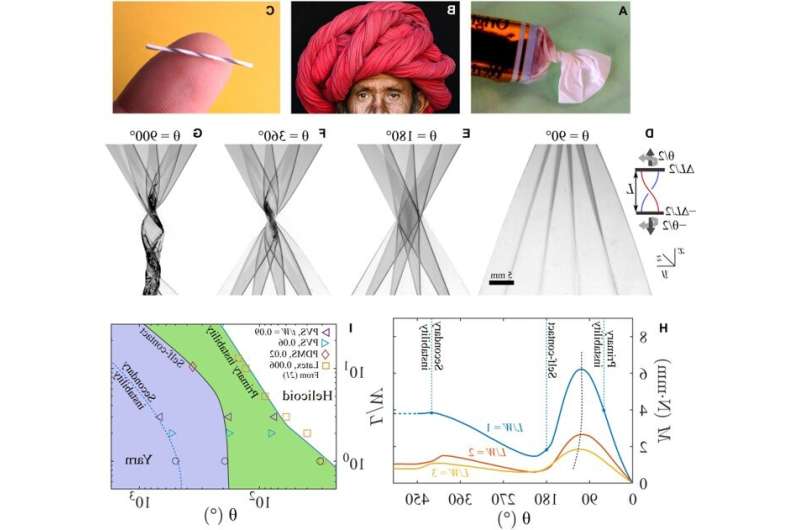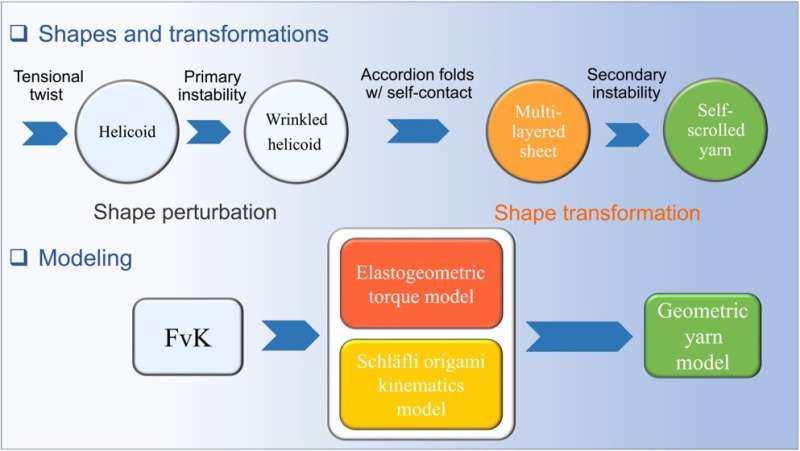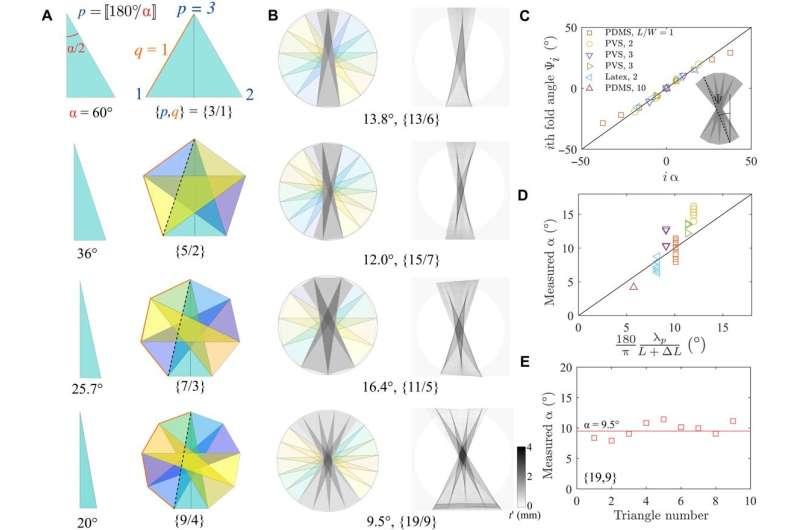April 26, 2022 feature
Kinematics of stretched sheets

In a new study now published as a report and also illustrated as the online cover-page of Science Advances, Julien Chopin, Arshad Kudrolli, and a research team in Physics in the U.S. and Brazil showed how twisted hyper-elastic sheets formed multi-layered self-scrolled yarns. By incorporating dominant stretching with folding kinematics, they measured torque and energetics originating from geometric nonlinearities. They then introduced a geometric model to explain the formation and structure of such self-scrolled yarns. The outcomes showed how a simple twist of origami in the tensional twist-folding framework led to the transformation of stretchable sheets into self-assembled architectures.
Shape transformation of sheets
Traditionally, twisting sheets can form functional yarns that rely on millennia of human practice to form catgut bow strings, surgical sutures and fabric wearables; however, the practice still lacks overarching principles that guide the intricacy of such architectures. Scrolled yarns with nested structures can be used to harness energy on batteries and in embedding amorphous materials. Tensional twist folding can transform flat sheets into layered structures via remote boundary regulation. Twist-folding and scrolling can be used to reconfigure and repurpose flat sheets as seen with the multifunctional Rajasthan turban.
To understand shape transformation of sheets and the interplay between topology and large shape transformations, Chopin et al used three-dimensional X-ray scanning to detail the spontaneous formation of twisted, multilayered yarns with ordered internal architectures. It is, however, still challenging to model the large shape transformations and configurations. Recent studies have incorporated elastic plate models including the Föppl–von Kármán (FvK) equation to solve the initial growth above the onset of primary instability, but such methods remain to explain the transformation of a flat sheet into scrolled yarns. In this work, Chopin et al developed a new framework to combine the kinematics of structured sheets, and used origami to explain these observations. The team showed how the folded sheets showed regular polygonal shapes as described by Schläfli symbols and how origami kinematics captured the main features of the structure to provide a framework that served as a guide to develop hyper-elastic materials with broad applications.

Torque with twist
The team showed examples of polydimethylsiloxane (PDMS) sheets with increasing twist. As the applied twist increased further, they noted the formation of a nested helical structure at the waist, followed by secondary instabilities and resulting recursive folding and a scrolled multilayered yarn. Each major shape transformation caused the rate of change of applied torque to change sign and form a saw-tooth variation with a twist.
Chopin et al illustrated the tensional twisting framework to understand the observed main stages of transformation of a planar sheet into self-scrolled yarns. They accomplished this by introducing a set of models to combine geometry, elasticity and kinematics to then capture the observed shape transformations. The researchers captured the stored elastic energy and torsional response and followed this work with 3D X-ray tomography to reconstruct twisted polyvinyl siloxane (PVS) sheets. The scientists then calculated the bending energy density using sheets with various Young's moduli and characterized the transfer with twist.

Elastogeometric torque model, self-folding and Schläfli origami
Based on the experimental observations, Chopin et al developed an elastogeometric model to calculate the stored elastic energy and torsional response of the sheet. They accomplished this by drawing inspiration from the tensional field theory to describe highly wrinkled sheets, where flexural and compressive stresses were negligible compared with tensile tresses. As in tensional field theory, Chopin et al assumed the energetics during folding to be predominantly given by stretching modes in the longitudinal direction, while the bending modes were subdominant. The team compared the measured torque as a function of twist relative to the hyper-elastic nature of the material and complemented their elastogeometric analysis with origami construction to show good agreement between the origami shape and the twisted sheet. The scientists then identified these origami using Schläfli symbols, which they then named Schläfli origami. By varying the Schläfli symbols, Chopin et al obtained triangle, pentagon-, heptagon- and nonagon-shaped envelopes. The work highlighted how origami kinematics underpinned tensional twist folding.

Yarn formation and the geometric yarn model
To model yarn growth, Chopin et al assumed that the sheet could be divided into three sections, to include a yarn-like structure of length, and two fan-like structures. This simplification allowed them to retain the fundamental role of the twisted sheet edge in the elastogeometric torque model. They also studied the evolution of yarn length by helical wrapping the fan edges around a cylindrical core of a specific diameter to ultimately form a growth model in good agreement with the experimental data.

Outlook
In this way, Julien Chopin, Arshad Kudrolli and colleagues described the remarkably ordered transformation of flat sheets to scrolled multilayered yarns. They accomplished this by introducing a series of simplified elastogeometric models to form a tensional twist-folding framework. The team explored the flat multilayered structure by introducing a Schläfli origami model, where the origami when twisted by a half-turn formed regular star-shaped polygons characterized via Schläfli symbols. Chopin et al used X-ray tomography analysis to explain the evolution of the sheet and indicated the composition of a highly twisted yarn region in the center and weakly twisted fan-like regions connected to the two clamps. The model incorporated in this work was based on simplified kinematics to provide a framework to enable multifunctional yarns using ultrathin polymers, carbon nanotubes, and graphene sheets, suited as materials with applications across medicine and flexible electronics. The scientists used PDMS (polydimethylsiloxane) and PVS (polyvinyl siloxane) polymers due to their hyperelasticity under different loading conditions. The resulting tensional twist-folding strategy can create re-deployable functional structures from simple elements for advanced manufacture with soft materials.
More information: Julien Chopin et al, Tensional twist-folding of sheets into multilayered scrolled yarns, Science Advances (2022). DOI: 10.1126/sciadv.abi8818
Joseph D. Paulsen et al, Optimal wrapping of liquid droplets with ultrathin sheets, Nature Materials (2015). DOI: 10.1038/nmat4397
Journal information: Nature Materials , Science Advances
© 2022 Science X Network




















